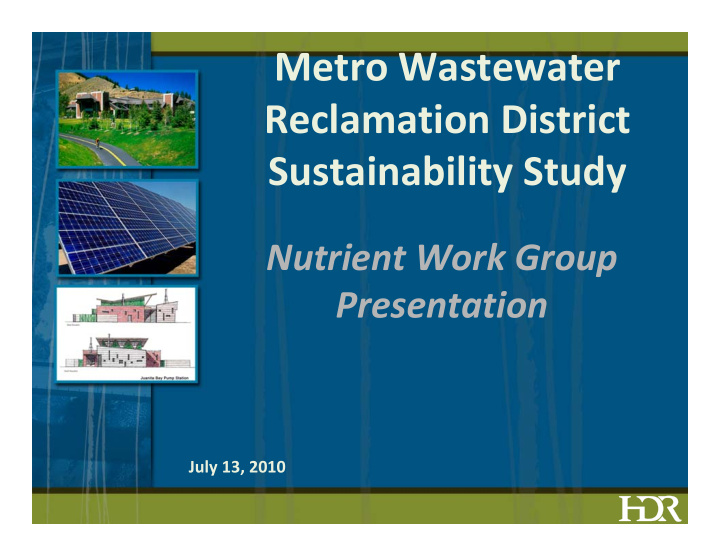



Metro Wastewater Reclamation District Sustainability Study Nutrient Work Group Presentation July 13, 2010
Overview • District Sustainability Goals • District Vision Statement • Successful Sustainability Programs • Current District Practices • Sustainable Decision Making
Sustainability Study Goals • Document Current District Currently Practices • Develop District Wide Sustainability Goals • Develop Sustainable Return on Investment (SROI) Framework
Defining Sustainability “Development that meets the needs of the present without compromising the ability of future generations to meet their own needs.” ‐ Brundtland Commission (The World Commission on Environment and Development, 1987)
Social Social What is Sustainability to the District? Environmental Environmental Water Quality Water Quality Leadership Leadership
Process for Developing the Sustainability Framework • Workshop 1 ‐ Vision and Goal • Workshop 2 ‐ Economics Setting Alum Alum (Cl2) Membrane rse Grit Primary Fine Screen N/DN MBR CCT Modules en Removal Clarifier CCT RAS MLR WAS Anaerobic Holding DAFT Digestion Tank (Ferric) TSL DFR Centrate Storage DC Disposal • Workshop 3 – Environmental • Workshop 4 – Sustainability and Social Analysis Framework
Sustainability Goals ‐‐ Environmental • Portfolio Approach to Optimize Power, Natural Gas, Water, Chemical Use • Incorporate Sustainable Principles into Facilities • Enhance Water Quality and Continue Environmental Stewardship of the River • Limit Greenhouse Gas Emissions Whenever Possible & Feasible • Balance Competing Environmental Priorities
Sustainability Goals ‐‐ Economic • Optimize Power, Natural Gas, Water, Chemical Use • Maximize Resource Recovery and Provide Flexibility to Market Changes • Maintain Flexibility for Processes to Meet Future Regulations • Cost ‐ Effective for Customers
Sustainability Goals ‐‐ Social • Be an Asset to the Community • Be a Leader in Sustainability • Mitigate Odors • Raise Awareness of Environmental Benefits (Air Quality / Water Quality / GHG emissions) • Form Partnerships to Contribute to Sustainable Community Development
District Vision Statement and Sustainability Approach • Provide Local, State and National Leadership by Optimizing Resources to Supply Clean Water for Current and Future Generations – Renewing Earth’s Resources
Characteristics of Successful Programs • Sustainability Vision • Establish Baseline • Establish Goals, Targets and Indicators • Localized Strategy for District • Comprehensive • Participation and Leadership • Monitoring, Reporting and Communication
Current District Practices • Robert W. Hite Facility • Northern Treatment Plant (RWHTF) (NTP) – Performed Survey of All – Eliminates a Number of Pump Departments Stations – Includes Extensive List – Consolidation • Cogeneration, Water Reuse, – Off Loading RWHTF and other Treatment Optimization, facilities Hybrid Vehicles, Biosolids – Facility planned to meet Program, etc capacity and treatment needs – Continual Updating today and 50 years from now Assessment Plot - MWRD Energy Management System Energy Audit 15.0 Bench-marking/ Tracking Energy Use Renewable Sources of Energy 10.0 Adoption of Plan-Do-Check-Act, 5.0 Energy Policy Management Systems 0.0 Measurement Energy Goals SOPs/Operational Controls Energy Management Action Plans Training & Awareness
Making Sustainable Decisions Based on the Triple Bottom Line
Sustainable Return on Investment Methodology A Four Step Process to Reveal the Hidden Value in Projects
Sustainable Return on Investment � SROI Adds to Traditional Financial Analysis the Monetized Value of Non ‐ cash Benefits and Externalities Project’s Cash Internal Non- Project’s Cash Impacts Cash Benefits Impacts Other Green Operations & Water Health & Criteria Air Capital (Community, House Waste Maintenance Quality Safety Contaminant Aesthetics) Gases Financial Return Financial + Internal SROI
Sustainable Return on Investment (SROI) Flow Diagram Example of Benefits Costs Non-Cash Cash Associated Capital Costs ($) Maintenance • Green House Gas Emissions Impacts • Electricity Costs Impact Costs ($) • Air Contaminant Emissions Impacts • Natural Gas Costs Impact • Water Quality Impacts • Biosolids Utilization • Odor Impacts • Operation & Maint. Costs Impact • Safety Impacts Operating Cost • Other Cash Impacts • Health Impacts Other Costs ($) Increases ($) Total Benefits ($) Discounting (%) Total Costs ($) Output Metrics ($) Reveals a project’s FULL VALUE
Example Structure and Logic Diagram
Example Analytical Results Provide Both Financial (FROI) and Sustainability Return on Investment (SROI) The Sustainability “S” Curve to Optimize the Total Value of Projects
Recommend
More recommend